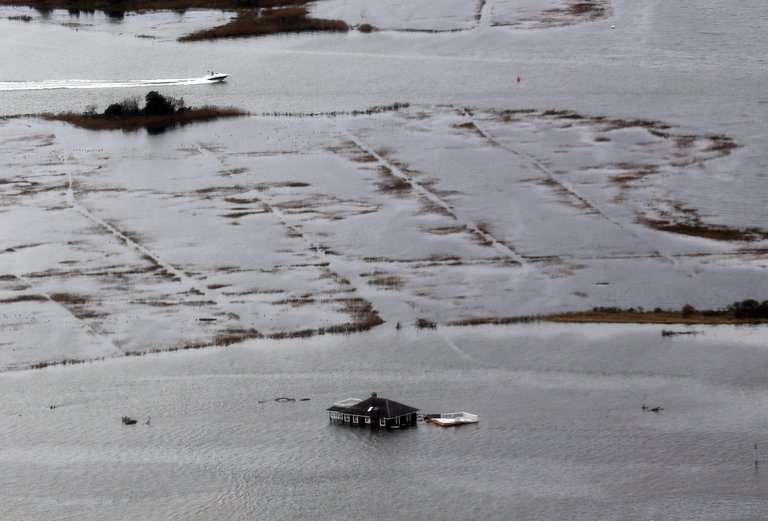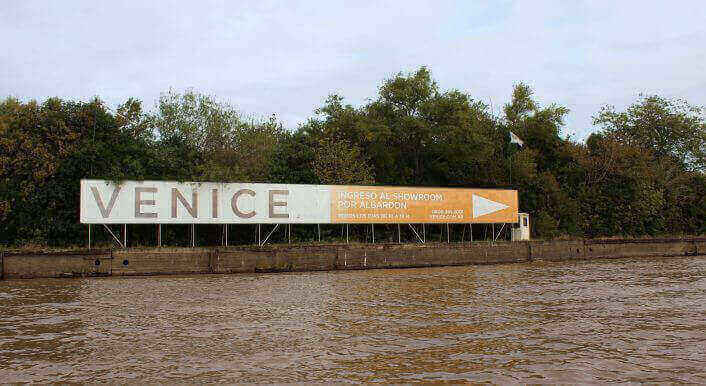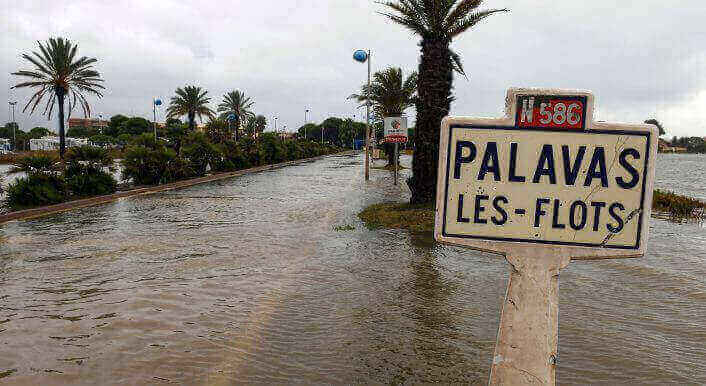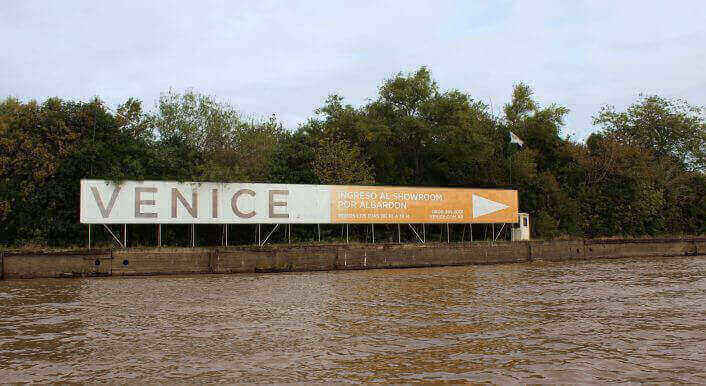USA: Octopus in the mall
Across North America coastlines are dramatically changing. The countless floods are so expensive that they surpass the price of Hurricane Sandy in 2012.

There was the octopus spotted swimming in a Miami parking garage in 2016. And the submerged roller coaster off the New Jersey coast during Superstorm Sandy in 2012. As well as islands, such as Lennox, off the coast of Prince Edward Island, and Alaska’s Kivalina that are being swiftly swallowed by the sea.
For the past six months, Columbia University’s Graduate School of Journalism’s Energy and Environment Program, in collaboration with Germany’s CORRECTIV and a global network of journalists, has documented global sea level rise and its effects worldwide.
For the first time, the collaboration is making accessible data from the Permanent Service of Mean Sea Level, a British organization that has recorded sea level at more than 2,000 stations worldwide since 1933.
And the measurements collected, along with more recent satellite data gathered by the United States’ National Air and Space Administration and other international government agencies, show the vast majority of North America’s coastlines are increasingly threatened by rising seas.
“Sea level rise is a global issue, and yet some places are being harder hit due to combinations of local factors“, said Gavin Schmidt, director of NASA’s Goddard Institute for Space Sciences. „This is particularly noticeable on the East Coast of the US, from Massachusetts to Florida and along the Gulf Coast.“
The combination of subsidence – the sinking of land due to groundwater loss or other natural forces — and the relentless creep of sea level rise has become a major risk for cities, transportation corridors and energy production centers along the coasts.
Indeed, a quick glance at a global sea level rise map produced by CORRECTIV shows rising seas along the continent’s Atlantic Coast, as well as along the perimeter of the Gulf of Mexico, where tidal gauges from Texas to New Foundland show steadily rising waters since 1961.
And as glaciers and polar ice caps continue to melt, and warming seas swell, these trends will only accelerate, say scientists.
Already, in Miami, where flooding is becoming increasingly common, the city government has pledged $100 million to raise roads, install pumps and redo sewer pipes and connections to stave off the encroaching seas and increasingly pervasive flooding.
But it’s not just city officials that are adapting. Residents, too, are accommodating to the changes. Indeed, in the South Sound neighborhood of Key Largo, Florida, local news reports showed residents renting SUVs to ford their way home after a recent spate of floods, wary their own cars wouldn’t make it. „…it might be time for residents to consider swapping cars for boats“, wrote the Miami Herald, paraphrasing local county officials.
And south Florida is hardly alone.
“The rise of ‘nuisance’ flooding, increasing salinity of groundwater and beach erosion are already costing communities millions of dollars and threatening the viability of many“, noted Schmidt, the NASA scientist.
Researchers at the University of California, Irvine showed the cumulative cost of minor flooding events in cities such as New York, Washington, D.C., Miami, San Francisco, and Seattle, is likely to exceed the cost of extreme and infrequent events.
“How much more sea level rise do you need before it becomes chronic?“ said Billy Sweet, an oceanographer with the U.S. National Oceanic and Atmospheric Administration [NOAA]. „We need to break the mold of [talking about] big storms, and talk about the cost of flooding people’s basements, repetitive mobilization costs to public safety for road closures, the cost of devaluing real estate properties, even the cost of car rotors busting“, said Sweet.
Sweet is spearheading an effort at NOAA to produce an inundation dashboard where communities can access current flooding information from annual and seasonal reports. „We’re trying to take the pulse on what are the conditions now“, said Sweet.
Consequences from rising waters are likely to be dramatic in North America, where some the continent’s largest and most populous cities lie adjacent to the coasts, with little elevation above.
Take for instance, New York City where sea level rise adaptation has been on the forefront of policy discussions since Hurricane Sandy. The Mayor’s Office has committed to a $20 billion comprehensive resiliency plan to repair and restore homes, schools, hospitals, water treatment plants and transit ways damaged by floodwaters.
The Category 1 storm devastated much of the Northeast, rattling 24 states and Caribbean islands such as Puerto Rico, which went into a state of emergency from the late October storm.
On October 30, 2012, 9,000 people across 13 states spent the night in 171 shelters operated by the Red Cross. „Don’t put your emergency power systems in their basement — that’s the lesson learned in New York“, said Jeffrey Marqusee, former executive director of the Office of the Secretary of Defense’s (OSD) Strategic Environmental Research and Development Program.

Doug Mills / Pool / AFP
Coastal bases, ports and airways owned by the U.S. Department of Defense are also at risk, said Marqusee, who directed research and development on adapting some of the Department of Defense’s coastal installations to climate change. „That’s the thing- that’s most difficult to predict“, said Marqusee. „We don’t do a good job of adapting coastal communities to current storms“, he said, much less future storms. The „real goal is to do better“, he said, „but let’s not make perfect the enemy of good.“
There are areas on CORRECTIV’s sea level map, however, that appear to have falling sea levels, as opposed to rising ones. In places such as Churchill, Manitoba — the polar bear capital of the world — sea level has dropped at a rate of 10.5 millimeters per year since 1961.
And in Skagway, Alaska, it’s been falling as much as 18 millimeters a year, since 1961. Similar trends have been noted in other northern latitudes, including Scandinavia, where land that was once compressed by ice sheets is now lifting as that weight melts.
“Ice is so heavy, it pushes down on the Earth. But when you take away weight, it pops back up“, said Regine Hock, glacier expert at the University of Fairbanks, Alaska. In Glacier Bay, Alaska, the land is rising at a rate of 30 millimeters per year: one of the highest uplift — also called isostatic rebound- rates in the world.
Still, glaciers play a significant role in global sea level rise. „I often hear, ‘Oh the glaciers are going to be gone in a few decades. They don’t matter anymore,’“ said Hock, who has dedicated much of her career to the study of these masses of ice. „They’re often forgotten, they’re seemingly so small.“ The mass input of glaciers into the oceans accounts for approximately 50% of sea level rise between 1992-2010, Hock said.
Alaska is also experiencing changes in permafrost — the frozen ground is thawing. „This is a big issue in Fairbanks where I come from, said Hock. „You drive around and see the real estate is so cheap! You see these houses, they’re really sinking into the ground!“
The loss of permafrost combined with sea level rise, and a reduction in sea ice has resulted in a devastating scenario in Alaska: The residents of several Alaskan villages, such as those in Shishmaref and Kivalina, are relocating as their towns get swallowed by the sea.
Whether more cephalopods appear in urban centers, houses sink into thawing soils and military bases drown under rising seas is pretty well established: They will. Maps and satellites make clear North America, like the rest of the globe, is undergoing dramatic changes as the planet’s climate changes.
Just how quickly, and how expensive it’ll all be, however, remains to be seen.
The author is part of the Energy and Environmental Reporting Project is part of Columbia Journalism School post-graduate fellowship program and is supported by the Blanchette Hooker Rockefeller Fund, Energy Foundation, Open Society Foundations, Rockefeller Brothers Fund, Rockefeller Family Fund, Lorana Sullivan Foundation and the Tellus Mater Foundation. The funders have no involvement in or influence over the articles produced by project fellows in collaboration with Correctiv.



